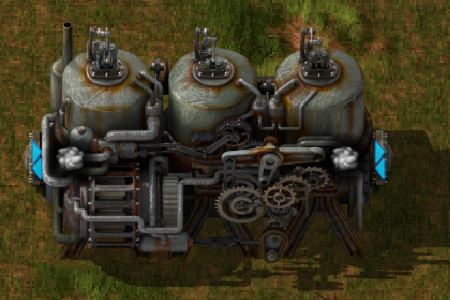Steam engine: Difference between revisions
(New infobox organization.) |
(removed outdated achievement) |
||
| Line 22: | Line 22: | ||
In general you should convert the unusable oil products into useables, instead of just making electricity out of it! | In general you should convert the unusable oil products into useables, instead of just making electricity out of it! | ||
== History == | == History == | ||
Revision as of 16:08, 22 July 2017
| Steam engine |
|
Recipe |
|
| + + + → | |
|
Total raw |
|
| + |
|
Recipe |
|
| + + + → | |
|
Total raw |
|
| + |
|
Map color |
|
|
Fluid storage volume |
200 |
|
Health |
400 |
|
Resistances |
Fire: 0/70% |
|
Stack size |
10 |
|
Dimensions |
3×5 |
|
Power output |
900 kW |
|
Maximum temperature |
165 °C |
|
Fluid consumption |
30/s |
|
Mining time |
0.3 |
|
Prototype type |
|
|
Internal name |
steam-engine |
|
Required technologies |
|
|
None required |
|
|
Produced by |
|
Steam engines are the most basic electricity generator, available to the player at the start of the game. They produce electricity by consuming steam, using water pumped from an offshore pump that was heated to 165°C steam with boilers or to 500°C steam with heat exchangers. Steam that has a higher temperature than the maximum temperature of the steam engine (165°C) does not yield more electricity, but less steam is consumed.
Steam engines will automatically adjust their power production and steam usage based on the current demands of the electricity network. Hovering the mouse over a steam engine will display their current power production (Performance) and their possible power production (Available Performance).
Steam engines have two ports, allowing excess steam to flow through. This allows steam engines to be chained together. The current optimal ratio is 1 offshore pump to 20 boilers to 40 steam engines.
Using steam engines for power does not produce pollution, unless boilers are used to heat up the water.
Before version 0.15
Steam engines produce electricity by consuming water that was and heated with boilers. Higher temperature water (up to 100 C) yields more electricity.
Steam engines have two ports, allowing excess water to flow through. The optimal ratio was 1 offshore pump to 14 boilers to 10 steam engines to 2.5 coal electric mining drills.
Using other liquids
The steam engine can use any type of liquid to generate electricity. This can be used to get rid of unused oil-products. Just fill unusable oil products into a steam engine and it will destroy the liquids (cold liquids will be destroyed at a rate of 6.0 fluid / second). It works the same as for cold water; you don't need to warm it. If you heat the liquid before that, the hot oil will produce electrical power, just like with hot water.
By default, water is 15°C and oils are 25°C. The steam engine happens to work with water from 15°C and oils from above 25°C (a complete coincidence). An oil temperature of 25.22°C will get you about 1.3KW of power. Heating up water or oils makes no difference: heating one liter of water from 15 to 16 degrees takes just as much energy as heating one liter of oil from 25 to 26 degrees(OC). It was not tested how much energy the steam engine produces with 16°C water versus 26°C oil, but it probably does not warrant using oils instead of water.
In general you should convert the unusable oil products into useables, instead of just making electricity out of it!
History
- 0.15.0:
- Steam is now internally a separate fluid from hot water.
- Added high graphics quality option for steam engine.
- Increased the maximum power production of steam engine from 510kW to 900kW
- Doubled the heat capacity of water from 0.1kJ per degree per liter to 0.2kJ.
- Change fluidbox height and base level of boiler, steam engine and pump to improve fluid flow.
- 0.10.7:
- Made bounding box smaller.
- 0.10.0:
- New graphics.
- New sounds.
- 0.5.1:
- New graphics
- 0.1.0:
- Introduced
